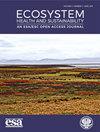热带沿海海域CO2通量与上升流-下升流系统的关系
IF 3.4
2区 环境科学与生态学
Q1 ECOLOGY
引用次数: 0
摘要
本文用涡动相关法测量了巽他陆架热带近海的CO 2通量,研究了季风与上升-下降过程之间的关系。关于上升-下降过程对影响该地区CO 2通量的物理-生物参数的共同影响的认识有限。本研究旨在确定影响通量的因素和趋势。从日平均叶绿素-α浓度的高(低)表现可以看出,上升(下降)流与东北(西南)季风重叠。叶绿素-α在上升流期升高,平均为1.70 mg m−3,而在下升流期下降至0.49 mg m−3。co2通量与海水温度和风速相关。在上升流-东北季风(下升流-西南季风)季节,co2通量为负(- 2.33 mmol m−2 day−1)(正,0.54 mmol m−2 day−1)。在气候小时尺度上,该模式表明,在下行-西南季风季节,可能由于较高的温度、较低的风速和较低的叶绿素-α水平,存在co2通量增加的正脉冲持续时间。相反,在上升流-东北季风季节,由于叶绿素-α浓度的增加,通量在白天短暂减少,在夜间由于温度降低和风速增加而减少。本文章由计算机程序翻译,如有差异,请以英文原文为准。
The Link between CO2 Flux and the Upwelling-Downwelling System of a Tropical Coastal Sea
This work presents the relationship between the monsoons and the upwelling–downwelling processes of the tropical coastal sea of the Sunda Shelf on CO 2 flux measured using the eddy covariance method. The understanding on the co-impact of upwelling–downwelling processes to physical–biological parameters that affect the CO 2 flux in the region is limited. This study aims to determine the factors and trends influencing the flux. We found that upwelling (downwelling) overlapped with the Northeast (Southwest) Monsoon as evidenced by the high (low) daily averaged chlorophyll-α concentrations. Increased chlorophyll-α with a mean of 1.70 mg m −3 was observed in the upwelling period, whereas in the downwelling period, it decreased to 0.49 mg m −3 . The CO 2 flux correlated with the seawater temperature and wind speed. The CO 2 flux was negative, −2.33 mmol m −2 day −1 (positive, 0.54 mmol m −2 day −1 ), in the upwelling-Northeast Monsoon (downwelling-Southwest Monsoon) season. On the climatological hourly timescale, this pattern showed that during the downwelling-Southwest Monsoon season, there were durations of increased, positive pulses of CO 2 flux, possibly because of higher temperatures, lower wind speeds, and low levels of chlorophyll-α. Conversely, in the upwelling-Northeast Monsoon season, there were periods of decreased flux, which occurred briefly during the day because of increasing concentrations of chlorophyll-α and at night due to lower temperatures and higher wind speeds.
求助全文
通过发布文献求助,成功后即可免费获取论文全文。
去求助
来源期刊

Ecosystem Health and Sustainability
Environmental Science-Management, Monitoring, Policy and Law
CiteScore
7.10
自引率
2.00%
发文量
40
审稿时长
22 weeks
期刊介绍:
Ecosystem Health and Sustainability publishes articles on advances in ecology and sustainability science, how global environmental change affects ecosystem health, how changes in human activities affect ecosystem conditions, and system-based approaches for applying ecological science in decision-making to promote sustainable development. Papers focus on applying ecological theory, principles, and concepts to support sustainable development, especially in regions undergoing rapid environmental change. Papers on multi-scale, integrative, and interdisciplinary studies, and on international collaborations between scientists from industrialized and industrializing countries are especially welcome.
Suitable topics for EHS include:
• Global, regional and local studies of international significance
• Impact of global or regional environmental change on natural ecosystems
• Interdisciplinary research involving integration of natural, social, and behavioral sciences
• Science and policy that promote the use of ecological sciences in decision making
• Novel or multidisciplinary approaches for solving complex ecological problems
• Multi-scale and long-term observations of ecosystem evolution
• Development of novel systems approaches or modeling and simulation techniques
• Rapid responses to emerging ecological issues.
 求助内容:
求助内容: 应助结果提醒方式:
应助结果提醒方式:


